I have Cimicifuga racemosa which is in flower now, C. americana, C. japonica which is about to flower. I have a third plant (actually dozens of them) which grows as tall as C. racemosa and starting to flower. The obvious difference is that the leaves are huge, as much as 9-10 in (20-25 cm) wide. Is this a different species or a form of racemosa?
Comments
Re: Cimicifuga
Wow, sounds wonderful! I'd love to see photos!
C. cordifolia sure sounds like a possibility... I only have the cultivar 'Blickfang' which has large leaves but not so large as you describe.
Re: Cimicifuga
Well, here's the difference caused by many degrees of latitude... my Actaea (Cimicifuga) racemosa have just started to bloom in what is almost mid-August, as compared to early July for Plummer in New York State! I love these plants... the 2 original plants have formed massive, stately clumps after many years:
Re: Cimicifuga
Well, here's the difference caused by many degrees of latitude... my Actaea (Cimicifuga) racemosa have just started to bloom in what is almost mid-August, as compared to early July for Plummer in New York State! I love these plants... the 2 original plants have formed massive, stately clumps after many years:
Started to bloom now? That's early compared to my plants. They are among the last ones to flower and typically bloom in October.
Re: Cimicifuga / Actaea
How much sun are those racemosa in? Mine do not stand that "stately".
Re: Cimicifuga / Actaea
The one plant is planted on the north side of a lattice trellis (as you can see in the photo) and gets about 8 hours of sun per day. The other plant is in slightly more sun (and is currently being swamped by Rosa 'Therese Bugnet'). It doesn't get hot here though.
Re: Cimicifuga / Actaea
8 hours of sun? Well it must be the heat factor then...I cannot imagine it here in even afternoon sun....but it sure looks better than mine ever have!
Re: Cimicifuga / Actaea
Our simplex are just flowering and are slightly over 6ft tall. Sun is not a factor here,they are planted in wet heavy soil and apart from five odd days it has rained every day since 5th May. What is sun?
Re: Cimicifuga / Actaea
... apart from five odd days it has rained every day since 5th May. What is sun?
Egad! Have there been mass suicides?!? :o :o Weather like that is really unimaginable here. What part of the UK are you in?
Re: Cimicifuga / Actaea
... apart from five odd days it has rained every day since 5th May. What is sun?
Egad! Have there been mass suicides?!? :o :o Weather like that is really unimaginable here. What part of the UK are you in?
Tony is nearer the coast, so slightly drier than me!!!! We seemed to miss three of those 'odd five days'. LOL.
We both live in Lancashire - midway (very approximately) between North Wales, The Lake District, The Peak District, The Yorkshire Dales and the North-West coast of England. I remember one lovely day in June, very warm rain indeed!
Re: Cimicifuga / Actaea
;D ;D
Wow, I know that people are amazed at what we put with through the winter, but I have to commend your mental strength in putting up with that!
For my reference (and for anyone else who may be similarly challenged in geography skills :)), here's a map of UK counties:
http://www.itraveluk.co.uk/maps/england/
Re: Cimicifuga / Actaea
I've been aching to post to this topic, as I'm nuts about Cimicifuga... and YES I've gone rogue and belligerently maintain Cimicifuga (dry capsules, a follicle) and Actaea (fleshy fruits, a berry) as distinctly separate genera. It's a genus with summer bloomers to fall bloomers, to those with incredibly fragrant flowers (C. simplex) to some with stinky flowers (C. foetida). I grow a number of forms of Cimicifuga simplex, including a few of the way-overpriced cultivars such as 'Brunette' and 'Hillside Black Beauty'. I grow the straight green-leaved form of C. simplex, as well as the beautiful purple-leaved forms (dark black purple stems too) known as the 'Atropurpurea Group', although don't know about the validity of such a name, perhaps a catch-all for purplish-leaved dark-stemmed versions. It is this latter version that provides the most interest, and is a fantastic garden giant.
Cimicifuga simplex (Actaea simplex) is typically noted as a species from Japan, although it also found in Korea, Mongolia, and Russia (Far East, E. Siberia):
http://www.efloras.org/florataxon.aspx?flora_id=2&taxon_id=200007575
Among it's many synonyms is Cimicifuga ramosa, not to be confused with C. racemosa (black bugbane), the latter being one of the stinky species, native to eastern half of North America (http://plants.usda.gov/java/profile?symbol=ACRA7). Unfortunately, these names are hopelessly confused in horticulture, so if you google "cimicifuga racemosa" you'll notice how this American species gets totally misapplied to Asian cultivars of C. simplex such as 'Brunette' and 'Hillside Black Beauty'. :rolleyes:
Regarding 'Brunette', 'Hillside Black Beauty', and possibly others, I do not find them as satisfactory as those that come under the broad category of the "atropurpurea group", the latter producing stately plants with a gorgeous blackish-purple tinge to the foliage, dark black-purple stems, and buds strongly suffused purple as well, adding rich contrast to the white flowers. Under good conditions, I have measured mine as reaching 8' (2.3 m), but they're always well over 6' (2m) tall. They start blooming late August but really come into their own around mid September, and continue into October. The entire yard is perfumed from the heady "burnt sugar" cotton candy perfume of the flowers.
They seed about with abandon, so be forewarned. Seedlings will shown lots of variation from all green, to dark purple-foliaged forms. I have allowed them to spread, as I dearly love the late season spectacle of arching spires of sweetly perfumes white perfection. Here are some recent photos, sorry about the photo quality, all were taken with my phone camera until I go out and buy a decent digital camera.
Cimicifuga simplex and "atropurpurea group" photos (Actaea simplex):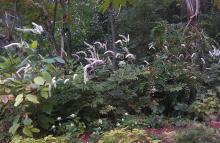
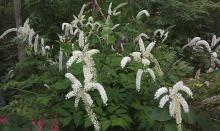
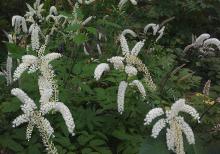
Re: Cimicifuga / Actaea
Wow, your plantings are just stunning!
C. simplex/ramosa 'Atropurpurea' is (or should I say "was", as I have lost them, unfortunately) a favourite of mine too - the pristine white flowers bursting from the dark, dark buds is very eye-catching. It would get to 6' for me, while the other cultivars you mention have never gotten anywhere near that height. Actually, they've done very poorly this year, no blooms even, which is odd given that much of the summer was quite wet.
I love the fragrance too (though none this year, unfortunately).
C. simplex blooms so late here - with the flowers often being killed off by frost before the bloom ends - that seeding around has never been a problem... I actually wouldn't mind it at all, especially seeing how magnificent your groves are!!
Re: Cimicifuga / Actaea
Seen in flower today at the Garden In The Woods, the display garden of the New England Wildflower Society, were Cimicifuga in abundance, most being a very tall, sparsely flowered species with maple-like leaves. I haven't yet checked the Flora of North America, I wondering what species it is.
Came across this one, with gorgeous broad rounded leaves in low mounds, and red-purple buds starting to open up to white flowers in upright spires... couldn't find a label, but it'll be an American species. Anyone know what it is?
Re: Cimicifuga / Actaea
Wow, your plantings are just stunning!
C. simplex/ramosa 'Atropurpurea' is (or should I say "was", as I have lost them, unfortunately) a favourite of mine too - the pristine white flowers bursting from the dark, dark buds is very eye-catching. It would get to 6' for me, while the other cultivars you mention have never gotten anywhere near that height. Actually, they've done very poorly this year, no blooms even, which is odd given that much of the summer was quite wet.
I love the fragrance too (though none this year, unfortunately).
C. simplex blooms so late here - with the flowers often being killed off by frost before the bloom ends - that seeding around has never been a problem... I actually wouldn't mind it at all, especially seeing how magnificent your groves are!!
Lori, I can save you some seed... I usually take the long "wands" down into my woods and whack them against the ground to release the seed. The seed pods are also VERY attractive, dark tinged in the "atropurpurea" forms... I have photos but haven't processed any with names (so I can't find them quickly), but will post some here in a while.
Here's a photo taken on Sept 24, 2006 of Hillside Black Beauty... while the foliage is very dark, it lacks the grace of C. simplex forms with very long arching spires, so while I have photographed C. simplex a million times, only have a couple shots of this overpriced form. As you mention, it is also shorter, and not a very robust grower, I'm disappointed with many of the named selections.
Re: Cimicifuga / Actaea
Maybe C. rubifolia (syn. cordifolia) for the first one?
The second one is especially intriguing!
Edit:
http://www.efloras.org/florataxon.aspx?flora_id=1&taxon_id=233500380
Re: Cimicifuga / Actaea
Thanks, Mark - I would appreciate it!
Oh, I forgot... I do have C. cordifolia 'Blickfang' blooming, so at least there is one!
Re: Cimicifuga / Actaea
Oh, I'm not familiar with that species or the cultivar (C. cordifolia 'Blickfang')... please show us here.
Thanks for the suggestion of Cimicifuga rubifolia for the first one I show from Garden In The Woods with maple like leaves, the drawing in Flora of North America does indeed look like it:
http://www.efloras.org/object_page.aspx?object_id=41069&flora_id=1
Interesting too, is that while the gross lumping of Cimicifuga (dry seed capsules) into Actaea (fleshy berries for seed), that the Flora of North America, and Flora of China, the two primary floras that engage the genus Cimicifuga, have steadfastly maintained the validity of Cimicifuga, and HAVE NOT followed the lemmings into the ridiculous lumping into Actaea. So, we can speak with confidence and certainty of Cimificuga... hooray!
Re: Cimicifuga / Actaea
The Flora of North America puts Cimicifuga cordifolia into synonymy with C. americana.
http://www.efloras.org/florataxon.aspx?flora_id=1&taxon_id=233500375
Re: Cimicifuga / Actaea
Thanks, Mark - I would appreciate it!
Oh, I forgot... I do have C. cordifolia 'Blickfang' blooming, so at least there is one!
Do you know what 'Blickfang' means? ;)
Re: Cimicifuga / Actaea
It's so good to hear of these plants under their sensible name, Cimicifuga. With the Plantfinder in the UK name changes become very rapidly brought into the horticultural world, perhaps with little sensitivity to gardeners! We have trouble growing these lovely late flowering plants in our dry garden, but I have previously grown the purple forms of simplex on the nursery. From seed they seemed to come quite true but the seed is matured so late that I always found germination to occur in the second spring following, compared with most other Ranunculaceae. Once or twice I tried dividing plants; they are very shallow rooting and form a hard, compact rootstock. Division is a little like that for hostas, chopping the plant up into small pieces with growing points, but actually worked very well, so I imagine new forms can be increased quite rapidly. They really are an elegant group of plants and I had no idea of the great variation within the genus. Lovely to see those posted here, even if I can't grow them!!
Re: Cimicifuga / Actaea
Thanks, Mark - I would appreciate it!
Oh, I forgot... I do have C. cordifolia 'Blickfang' blooming, so at least there is one!Do you know what 'Blickfang' means? ;)
Best I can determine, 'Blickfang' means "eye-catcher" in Dutch:
http://de.wikipedia.org/wiki/Blickfang
Perhaps this cultivar of an American species was named in a nursery in the Netherlands, perhaps accounting for the use of the synonym species.
Re: Cimicifuga / Actaea
They really are an elegant group of plants and I had no idea of the great variation within the genus. Lovely to see those posted here, even if I can't grow them!!
The one I show from Garden In The Woods, with those luxuriant wide and thick-textured leaves, does not fit the description of the 6 species listed in Flora of North America! There is a possibility it is a species from outside of North America, every now and then this particular garden "breaks its own rules" of only planting North American plants and one finds Asiatic counterparts planted (for example, they had both Jeffersonia diphylla and J. dubia planted), possibly to help illustrate the well-known close relationship between some eastern North American flora with curiously disjunct representatives in the Far East. I plan on contacting the staff at Garden In The Woods to ask what species it is.
It's so good to hear of these plants under their sensible name, Cimicifuga. With the Plantfinder in the UK name changes become very rapidly brought into the horticultural world, perhaps with little sensitivity to gardeners!
It's a curious thing, to see the quick adoption by an institution like the New England Wildflower Society adopt the whole Actaea lumping business, with Cimicifuga plants in their plant-sales area labeled Actaea, while the governing authority for the Flora of North America retains Cimicifuga, as does the governing authority in Asia where half the species live (Flora of China) also fully support Cimicifuga. In fact, all the other locations where Cimicifuga are found, the Floras support Cimicifuga as distinct and not lumped into Actaea, see the following links:
North America:
http://www.efloras.org/florataxon.aspx?flora_id=1&taxon_id=107092
China:
http://www.efloras.org/florataxon.aspx?flora_id=2&taxon_id=107092
Nepal:
http://www.efloras.org/florataxon.aspx?flora_id=110&taxon_id=107092
Pakistan:
http://www.efloras.org/florataxon.aspx?flora_id=5&taxon_id=107092
Taiwan:
http://www.efloras.org/florataxon.aspx?flora_id=101&taxon_id=107092
Ornamental Plants From Russia And Adjacent States Of The Former Soviet Union
http://www.efloras.org/florataxon.aspx?flora_id=120&taxon_id=107092
The scientific publication Novon (Harvard University, Cambridge Massachusetts, USA), published a recent paper (2004) describing two new Cimicifuga taxa; Cimicifuga austrokoreana from Korea, and Cimicifuga elata var. alpestris from Southern Oregon, USA; it includes some fine line drawings:
http://flora.huh.harvard.edu/china/novon/novo-14-02-180.pdf
So, who the hey is it that lumps Cimicifuga into Actaea, seems that the overwhelming body of taxonomic science retains Cimicifuga as valid.
A photo on the left of a rich raspberry red berry form on Actaea seen at Garden In The Woods (not sure which of the two American species it is; rubra or pachypoda). On the right is the drying/ripening seed capsules on Cimicifuga simplex "atropurpurea group" in which the pods are also very dark, nearly black; photo from mid October 2009.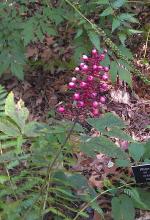
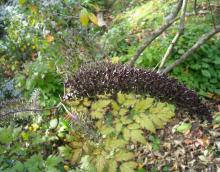
Re: Cimicifuga / Actaea
Took some photos today of Cimicifuga simplex 'Brunette'. It's a very VERY slow grower, with dark foliage that lightens up over the summer (true of many of the "black leaf" varieties of C. simplex), but showing strong purplish coloration to the buds and black-purple stems. The flower head remains mostly upright and is more dense than normal. I like it, but I would expect much more height and clumping up after 5 years, it is about 2-1/2' tall (75 cm) and only a single flowering stem; the purple-leaf forms of C. cimicifuga "Atropurpurea Group" are much more prolific with bloom and much better plants in my opinion. However, if you want a smaller version of C. simplex, this might be the right ticket.
Re: Cimicifuga / Actaea
Seedlings of Cimicifuga simplex come up EVERYWHERE, it could potentially become invasive. With both the all-green and dark-purple leaved forms, seedlings show up in both color forms and all kinds of intermediates. I'm much more inclined to rogue out the all green ones in favor of the purple leaf types. In this photo of two varying self-sown seed types, even this late in the season (mid September) where the the purple coloration can fade, the leaf color difference is quite strong. In spring, the emerging and developing foliage is nearly all black-purple on the better forms. The stems are virtually jet black, making a bold statement in the garden.
Re: Cimicifuga / Actaea
Thanks, Mark - I would appreciate it!
Oh, I forgot... I do have C. cordifolia 'Blickfang' blooming, so at least there is one!Do you know what 'Blickfang' means? ;)
Best I can determine, 'Blickfang' means "eye-catcher" in Dutch:
http://de.wikipedia.org/wiki/BlickfangPerhaps this cultivar of an American species was named in a nursery in the Netherlands, perhaps accounting for the use of the synonym species.
That was the translation I found as well, and yes, European cultivars are often given "catchier" names for sales in North America. I planted it last year if I'm remembering correctly. Here's a fuzzy photo of it from Sept. 3rd, somewhat beaten up by hail (and the photo is severely cropped to exclude the house's water meter!)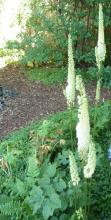
Re: Cimicifuga / Actaea
Lori, it looks to be a good one with clean white flowers. By the way, if one zooms in, I can still see the water meter ;D
Re: Cimicifuga / Actaea
I bought Actea pachypoda 'Misty Blue' yesterday which has really beautiful foliage. I had not heard of it before but when it grows and produces its white berries as well it will look fantastic. I see the label says 2 metres+ but in reality I expect it to be the same as my other form about 75 cms. It should not have any problems with the climate,it has been raining apart from one day for the past five weeks which is why I am sat at my pc in the middle of the morning!!!
Re: Cimicifuga / Actaea
I asked just to tease you - sorry ;)
Blickfang (blickfång actually) is Swedish too. In Norwegian it is spelt "blikkfang" and it means eye-cather as you suggests.
Here all Actaea is early flowering and seeds ripen but Cimicifuga is very late flowering and seeds almost never ripen so no trouble with seedlings though! I find Actaea seed germinates easily but Cimicifuga is more difficult.
All my Actaeas is from seed (here A. pachypoda) while I have to buy plants of Cimicifugas (here C. racemosa simplex). Both pictures taken today. (Bad quality though; a gloomy damp day.)
Re: Cimicifuga / Actaea
A couple of eye-catchers Trond! The fruiting structures on true Actaea are one of nature's miracles, how they can be lumped into the dry-follicle seed structures on Cimicifuga is beyond me.
Here's a side-by-side composite view of Cimicifuga simplex starting to form dense spires of seed capsules, on the left, bright lime-green on the all-green leaved forms of C. simplex, and on the right, dark purplish capsules on the "atropurpurea" forms of the species.
Re: Cimicifuga / Actaea
Greetings Aaron, so glad that you made it here to NARGS Forum! Your commentary and insight on Cimicifuga/Actaea are most welcome, looking forward to hearing from you often on the forum. I did a quick search and found the following link to a JSTOR document (for purchase) on the three species of Cimicifuga including C. purpurea.
Taxonomic Notes on Cimicifuga purpurea, Stat. Nov.
http://www.jstor.org/pss/3392219
Re: Cimicifuga / Actaea
I bought Actea pachypoda 'Misty Blue' yesterday which has really beautiful foliage.
I know this variety is relatively new. I am just wondering Tony et al how this plant did for you this past season in your garden?
I have two small ones that I purchased a week or so ago and depending on the final growth dimensions I am debating whether to plant both together to maybe get more impact from flowers and eventually berries or go with just one and give the other away (nice of me eh? ;))

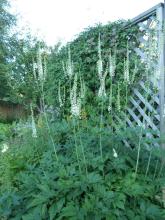
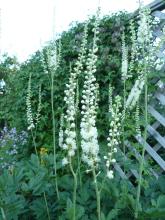
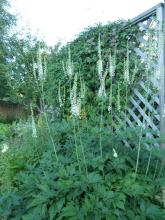
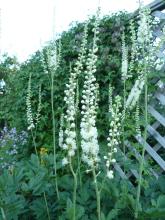
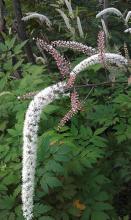
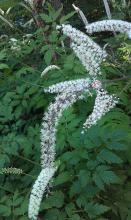
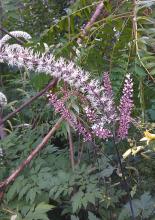
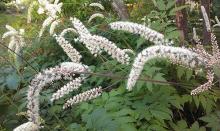
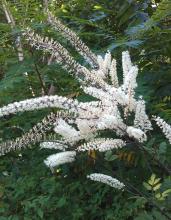
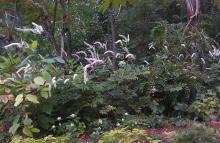
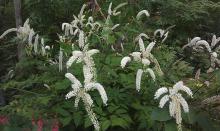
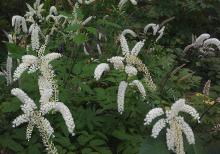
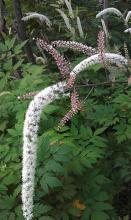
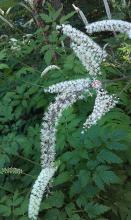
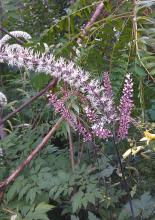
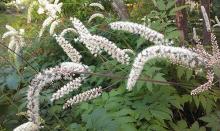
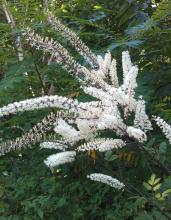
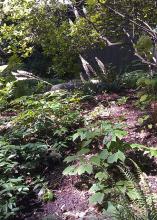
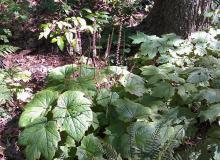
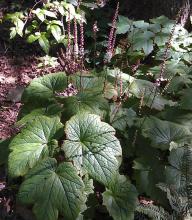
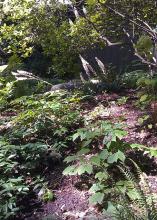
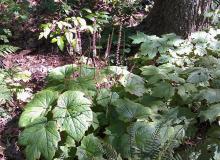
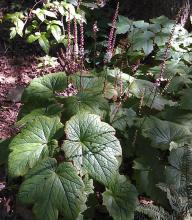
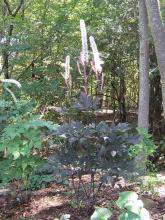
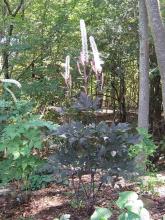
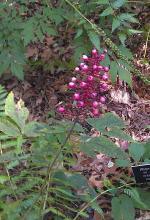
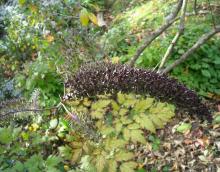
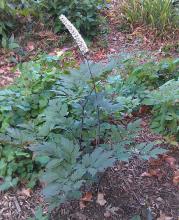
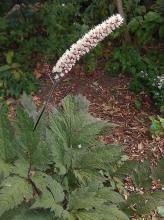
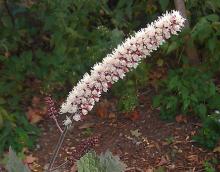
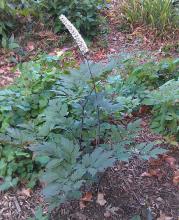
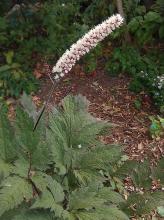

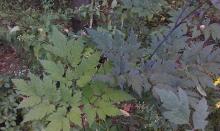
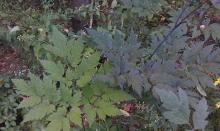
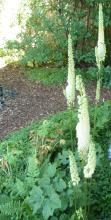
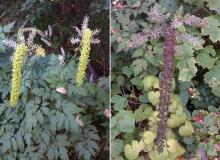
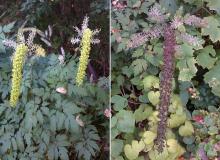
Possibly cordifolia?